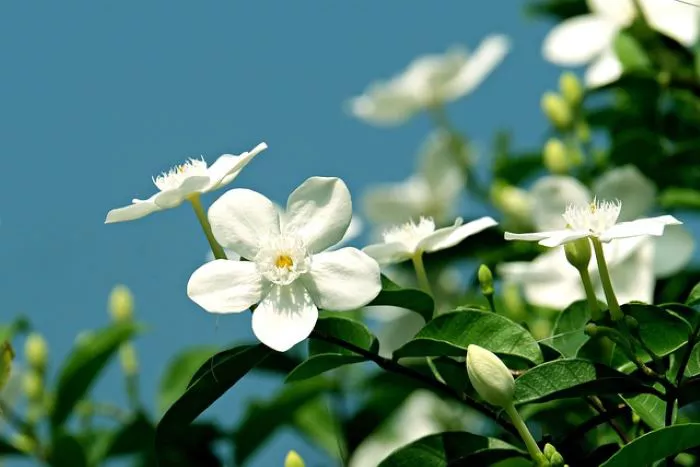Jasmine flowers are among the most beloved and widely recognized blooms in the world. Known for their enchanting fragrance and delicate beauty, these flowers belong to the genus Jasminum, which includes over 200 species. Each species has its own unique characteristics, making jasmine a diverse and fascinating group of plants. This article will explore the various types of jasmine flowers, their features, and their uses.
Overview of Jasmine Species
Jasmine is a genus in the Oleaceae family, which also includes olive trees. The genus Jasminum is primarily native to tropical and subtropical regions. While many species are cultivated for their ornamental value, others are valued for their fragrance, medicinal properties, and culinary uses. The diversity of jasmine species allows for a wide range of applications in gardens, perfumes, and traditional medicine.
Common Jasmine (Jasminum officinale)
Common jasmine is one of the most well-known species. It is native to the Mediterranean region and is prized for its sweet, intoxicating fragrance. The flowers are small, usually white or pale yellow, and bloom in clusters. Common jasmine is often used in perfumery and aromatherapy due to its rich scent. It is also a popular choice for gardens, where it can climb trellises and walls.
Arabian Jasmine (Jasminum sambac)
Arabian jasmine, also called sambac jasmine, is another highly fragrant species. It is native to Southeast Asia and is often used in traditional garlands and floral arrangements. The flowers are typically white and have a strong, sweet scent that is more intense than that of common jasmine. Arabian jasmine is widely used in the production of jasmine tea, where its aromatic flowers are used to infuse green or white tea leaves.
Italian Jasmine (Jasminum humile)
Italian jasmine, or yellow jasmine, is known for its vibrant yellow flowers and sweet fragrance. This species is native to the Mediterranean region and is often used in gardens for its beautiful blooms and pleasant aroma. The scent of Italian jasmine is lighter and more citrusy compared to other jasmine varieties. It is commonly used as a ground cover or in landscaping due to its vigorous growth and attractive flowers.
Jasmine Grandiflorum (Jasminum grandiflorum)
Jasmine grandiflorum, also known as Spanish jasmine or royal jasmine, is esteemed for its exquisite fragrance. The flowers are large, white, and emit a strong, sweet scent that is often described as creamy and rich. This species is particularly popular in high-end perfumery and is often used to create jasmine absolute. The complex aroma of jasmine grandiflorum makes it a favorite among fragrance enthusiasts.
Star Jasmine (Trachelospermum jasminoides)
Although not a true jasmine, star jasmine is often included in discussions about jasmine flowers due to its similar appearance and fragrance. Star jasmine is a climbing vine native to East Asia. It produces small, white, star-shaped flowers with a sweet scent. This plant is commonly used in landscaping and as a ground cover. Its fragrant blooms are attractive to pollinators and can enhance outdoor spaces.
Jasmine Polyanthum (Jasminum polyanthum)
Jasmine polyanthum, also known as pink jasmine, is native to China and is known for its clusters of small, pinkish-white flowers. The scent of pink jasmine is sweet and strong, making it a popular choice for gardens and trellises. This species is often used in perfumes and scented products, adding a unique floral note.
Jasmine Nudiflorum (Jasminum nudiflorum)
Jasmine nudiflorum, commonly known as winter jasmine, is a hardy species that blooms in winter. Its bright yellow flowers appear on bare stems, providing a splash of color during the colder months. Winter jasmine is often used in gardens for its early blooms and ability to thrive in various conditions. While its fragrance is less intense than other jasmine species, its cheerful appearance makes it a favorite among gardeners.
Jasmine Mesnyi (Jasminum mesnyi)
Jasmine mesnyi, or primrose jasmine, is another species known for its bright yellow flowers. Native to East Asia, this species is a deciduous shrub that produces fragrant blooms in spring. The flowers are trumpet-shaped and attract pollinators. Jasmine mesnyi is often used in landscaping for its vibrant color and pleasant scent.
Jasmine Species in Cultivation
In addition to the species mentioned, there are many other jasmine varieties cultivated for their ornamental and fragrant qualities. Some species are hybrids or cultivars developed for specific traits, such as increased fragrance or disease resistance. Gardeners and horticulturists often select jasmine varieties based on their growing conditions, desired fragrance, and aesthetic appeal.
Conclusion
Jasmine flowers encompass a diverse range of species, each with its own unique characteristics and uses. From the sweet scent of common jasmine to the vibrant blooms of winter jasmine, these flowers have captured the hearts of many. The versatility of jasmine makes it a popular choice in gardens, perfumery, and traditional medicine. Understanding the different types of jasmine can help enthusiasts choose the right variety for their needs, whether for fragrance, beauty, or cultural significance. With over 200 species to explore, jasmine continues to be a cherished and celebrated group of plants.


